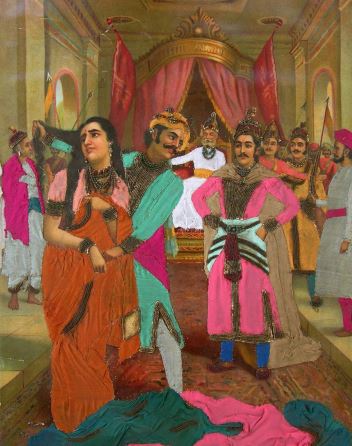From UPSC perspective, the following things are important :
Prelims level: Raja Ravi Varma
Mains level: Evolution of modern indian art

Ahead of the 175th birth anniversary fete of the legendary artist Raja Ravi Varma, erstwhile royal family of Kilimanoor has urged the Union government to posthumously confer the Bharat Ratna, the country’s highest civilian award, on him.
Raja Ravi Varma

- Raja Ravi Varma was born in April 1848 in Kilimanoor, Kerala, to a family which was very close to the royals of Travancore.
- Often referred to as the father of modern Indian art, he is widely known for his realistic portrayal of Indian gods and goddesses.
- While he majorly painted for the royalty, he is also credited for taking art to the masses with his prints and oleographs.
- At a young age, he would draw animals and everyday scenes on the walls in indigenous colours made from natural materials such as leaves, flowers and soil.
- His uncle, Raja Raja Varma, noticed this and encouraged his talent.
- Patronised by Ayilyam Thirunal, the then ruler of Travancore, he learnt watercolour painting from the royal painter Ramaswamy Naidu, and later trained in oil painting from Dutch artist Theodore Jensen.
How he become an artist of the royals?
- Varma became a much sought-after artist for the aristocrats and was commissioned several portraits in late 19th century.
- Arguably, at one point, he became so popular that the Kilimanoor Palace in Kerala opened a post office due to the sheer number of painting requests that would come in for him.
- He travelled across India extensively, for work and inspiration.
Fame as a notable painter
- Following a portrait of Maharaja Sayajirao of Baroda, he has commissioned 14 Puranic paintings for the Durbar Hall of the new Lakshmi Vilas Palace at Baroda.
- Depicting Indian culture, Varma borrowed from episodes of Mahabharata and Ramayana for the same.
- He also received patronage from numerous other rulers, including the Maharaja of Mysore and Maharaja of Udaipur.
- As his popularity soared, the artist won an award for an exhibition of his paintings at Vienna in 1873.
- He was also awarded three gold medals at the World’s Columbian Exposition in Chicago in 1893.
Nature of his artforms
- Much of his celebrated art also borrows heavily from Indian mythology.
- In fact, he is often credited with defining the images of Indian gods and goddesses through his relatable and more realistic portrayals often painted with humans as models.
- The depictions include Lakshmi as the goddess of wealth, Saraswati as the goddess of knowledge and wisdom, and Lord Vishnu with his consorts, Maya and Lakshmi.
How he took Indian art to the masses?
- Raja Ravi Varma aspired to take his art to the masses and the intent led him to open a Lithographic Press in Bombay in 1894.
- The idea, reportedly, came from Sir T Madhava Rao, former Dewan of Travancore and later Baroda, in a letter where he pointed out to Varma that since it was impossible for him to meet the large demand for his work, it would be ideal for him to send some of his select works to Europe and have them produced as oleographs.
- Varma, instead, chose to establish a printing press of his own.
- The first picture printed at Varma’s press was reportedly The Birth of Shakuntala, followed by numerous mythological figures and saints such as Adi Shankaracharya.
Major works
- It is believed that he had made around 7,000 paintings before his death at the age of 58.
- But only one painting is now left in ‘Chithrashala,’ the artist’s studio at Kilimanoor Palace — an unfinished portrait of ‘Parsi lady’ which was his last work.
- Some of his popular works include ‘Lady in the Moonlight’, ‘Nair Lady Adorning Her Hair’, ‘Malabar Lady with Violin’, ‘Lady with Swarbat’, and ‘Maharashtrian Lady with Fruits’.
Try this PYQ:
There are only two known examples of cave paintings of the Gupta period in ancient India. One of these is paintings of Ajanta caves. Where is the other surviving example of Gupta paintings?
(a) Bagh caves
(b) Ellora caves
(c) Lomas Rishi cave
(d) Nasik caves
Post your answers here.
Back2Basics: Bharat Ratna
- Bharat Ratna – ‘Jewel of India’ is the highest civilian award of the country.
- It is conferred for exceptional Service to the nation in various fields such as Science arts, literature and recognition of public service of the highest order.
- The award can be granted posthumously and since its establishment, seven awards were granted posthumously.
- The award was established by formal President of India Rajendra Prasad on 2nd January 1954.
- The concept of awarding this award posthumously was not there in the original statute declared in January 1954.
- Provision to award posthumously was finally added in January 1966 statute of this prestigious award.
- The medallion is cast in Bronze.
- The medallion is designed like the leaf of a pipal tree with a sunburst in the centre and Bharat Ratna is engraved underneath it.
UPSC 2023 countdown has begun! Get your personal guidance plan now! (Click here)
Get an IAS/IPS ranker as your 1: 1 personal mentor for UPSC 2024

A
Ellora Caves
b
bagh cave
Nasik caves may be
Bagh it is………..its previous year question u should remember
ellora caves